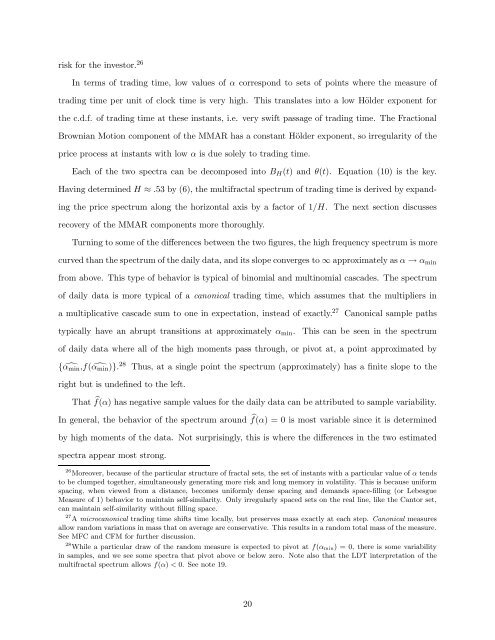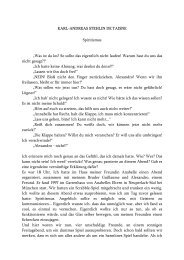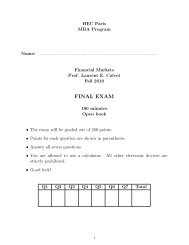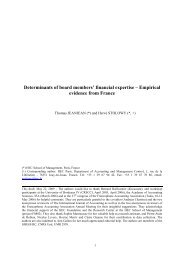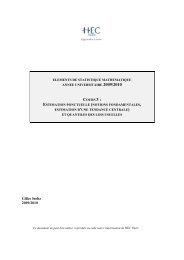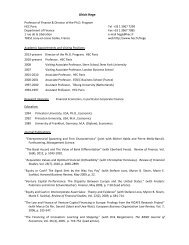Multifractality of US Dollar/Deutsche Mark Exchange Rates - Studies2
Multifractality of US Dollar/Deutsche Mark Exchange Rates - Studies2
Multifractality of US Dollar/Deutsche Mark Exchange Rates - Studies2
Create successful ePaper yourself
Turn your PDF publications into a flip-book with our unique Google optimized e-Paper software.
isk for the investor. 26<br />
In terms <strong>of</strong> trading time, low values <strong>of</strong> α correspond to sets <strong>of</strong> points where the measure <strong>of</strong><br />
trading time per unit <strong>of</strong> clock time is very high. This translates into a low Hölder exponent for<br />
the c.d.f. <strong>of</strong> trading time at these instants, i.e. very swift passage <strong>of</strong> trading time. The Fractional<br />
Brownian Motion component <strong>of</strong> the MMAR has a constant Hölder exponent, so irregularity <strong>of</strong> the<br />
price process at instants with low α is due solely to trading time.<br />
Each <strong>of</strong> the two spectra can be decomposed into BH(t) andθ(t). Equation (10) is the key.<br />
Having determined H ≈ .53 by (6), the multifractal spectrum <strong>of</strong> trading time is derived by expand-<br />
ing the price spectrum along the horizontal axis by a factor <strong>of</strong> 1/H. The next section discusses<br />
recovery <strong>of</strong> the MMAR components more thoroughly.<br />
Turning to some <strong>of</strong> the differences between the two figures, the high frequency spectrum is more<br />
curved than the spectrum <strong>of</strong> the daily data, and its slope converges to ∞ approximately as α → αmin<br />
from above. This type <strong>of</strong> behavior is typical <strong>of</strong> binomial and multinomial cascades. The spectrum<br />
<strong>of</strong> daily data is more typical <strong>of</strong> a canonical trading time, which assumes that the multipliers in<br />
a multiplicative cascade sum to one in expectation, instead <strong>of</strong> exactly. 27 Canonical sample paths<br />
typically have an abrupt transitions at approximately αmin. This can be seen in the spectrum<br />
<strong>of</strong> daily data where all <strong>of</strong> the high moments pass through, or pivot at, a point approximated by<br />
{ αmin,f( αmin)}. 28 Thus, at a single point the spectrum (approximately) has a finite slope to the<br />
right but is undefined to the left.<br />
That f(α) has negative sample values for the daily data can be attributed to sample variability.<br />
In general, the behavior <strong>of</strong> the spectrum around f(α) = 0 is most variable since it is determined<br />
by high moments <strong>of</strong> the data. Not surprisingly, this is where the differences in the two estimated<br />
spectra appear most strong.<br />
26 Moreover, because <strong>of</strong> the particular structure <strong>of</strong> fractal sets, the set <strong>of</strong> instants with a particular value <strong>of</strong> α tends<br />
to be clumped together, simultaneously generating more risk and long memory in volatility. This is because uniform<br />
spacing, when viewed from a distance, becomes uniformly dense spacing and demands space-filling (or Lebesgue<br />
Measure <strong>of</strong> 1) behavior to maintain self-similarity. Only irregularly spaced sets on the real line, like the Cantor set,<br />
can maintain self-similarity without filling space.<br />
27 A microcanonical trading time shifts time locally, but preserves mass exactly at each step. Canonical measures<br />
allow random variations in mass that on average are conservative. This results in a random total mass <strong>of</strong> the measure.<br />
See MFC and CFM for further discussion.<br />
28 While a particular draw <strong>of</strong> the random measure is expected to pivot at f(αmin) = 0, there is some variability<br />
in samples, and we see some spectra that pivot above or below zero. Note also that the LDT interpretation <strong>of</strong> the<br />
multifractal spectrum allows f(α) < 0. See note 19.<br />
20


